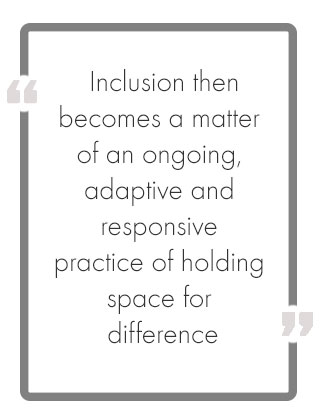In her book, Space Invaders: Race, Gender and Bodies Out of Place, Nirmal Puwar (2004) highlights how the spaces we come to occupy are imbued with gendered, racialised, and classed histories and meanings. She argues that diversification has often been framed as adding ‘people who look different’ (most often, people of colour), without actually addressing how the qualities, principles and structures that institutional spaces are built upon are inherently white, middle-class, non disabled-bodied, heterosexual, and cisgender. This not only frames white people as a static and homogenous group (ignoring for instance the inflections of class, gender and ability) but it also ends up being tokenistic. A politics centred only on ‘looking different’ justifies the idea that being a woman and/or a person of colour is enough to represent the interests of the marginalised groups they belong to. In recent times, this was evident in the dismissive response of the British Secretary of State, Priti Patel, towards Black Lives Matters (BLM) protests. This brand of inclusion and diversity only goes so far, as long as existing structures that sustain whiteness are not ruffled.
Whilst inclusive practice needs to recognise and address systemic inequalities, thereby destabilising established hierarchies, there is a risk of essentialising¹ what this looks like in everyday practice. We contend that teachers should be equipped to adapt to the ever-changing needs of a classroom.

Unsettling traditional boundaries of exclusion inadvertently produces new boundaries and, in turn, new exclusions. For example, the introduction of ramps for wheelchair access are integral, but they may present issues for students with visual impairments that can’t navigate uneven gradients. Universal Design advocates have done a lot of valuable thinking around how to make infrastructures maximally accessible, such as adding grip tape for traction and visual cues. However, other forms of inclusion are mutually exclusive. For instance, some learners need noise to concentrate, whilst others need silence. Physical infrastructures and policy documents for diversity and inclusion can only go so far. They cannot grapple with the continual, complex and fluctuating nature of ex/inclusions. These scenarios require more adaptive solutions than static infrastructures. Inclusion then becomes a matter of an ongoing, adaptive and responsive practice of holding space for difference.
It is this kind of responsiveness that Montessori referred to when she spoke of ‘the spirit triumphing over the mechanism’ (Montessori, 1997, p.7). Therefore, becoming inclusive is not about following prescribed checklists or simply creating anti-discriminatory policies; it is about the ongoing practice of remaining attentive to dynamics. This might involve knowing when to strategically essentialise² (Spivak, in Grosz, 1985) and when to respond with nuance and complexity. For instance, subscribing to the subtleties of skin tones and shades to complicate conversations about race, i.e. where whiteness is rejected for tones such as ivory, porcelain, peach, sienna and so forth, can inadvertently mask privilege that comes with being white and further silence the concerns of those from BIPOC³ communities who may have very specific requirements from white folks on how they can be effective allies. Other times, essentialising the experiences of a marginalised group can end up being oppressive. For example, generalising the experiences of queer and trans folks can limit the mulitiplicities, the possibilities and the agencies of queer and trans folks who wish to be authors of their own experiences. There are no quick fixes. Engaging with difference can be uncomfortable, but sitting with that discomfort is part of being responsible and responsive to the ongoing needs of students.
‘I give very few lessons on how to give lessons, lest my suggestions – becoming stereotypes and parodies – should turn into obstacles instead of help. The directress is dealing with different personalities and it therefore becomes more a question of how she should orient herself in what is for her a new world, rather than any rigid and absolute rules’ (Montessori, in Standing,1998, p.307)
Authors:

And Pasley is presently a PhD candidate in the Faculty of Education and Social Work at the University of Auckland. Their research broadly focuses on gender, sex , sexuality, and posthuman theory. Their doctoral research looks at the ways in which trans students’ lives matter in Aotearoa New Zealand , employing an Agential Realist lens. They have been teaching sexualities education since 2016 and currently lecture on trans lives, transnormativities, and disability and sexuality.

Sid Mohandas is a PhD student from Middlesex University, London UK, investigating gender within Montessori early childhood spaces using feminist new materialist theories. He is also the founder of The Male Montessorian and Montistory.

Scott Kerpen is a PhD student from Cardiff University exploring possibilities for queer masculinity and queering masculinity in the digital age. His work draws on new materialist and psychoanalytic theory to explore possibilities of negotiating gender and sexuality in a social and material LGBTQ+ culture dominated by commercial interests.
Acknowledgment:
Thanks to Andy Lulka, Laura Flores Shaw, Ashley Speed, and Hannah Baynham for their valuable feedback on earlier versions of the article.
Notes:
¹ Essentialism is the notion that a social category has fixed, inherent and permanent attributes.
² Strategic Essentialism is a strategy by which differences (within a group) are temporarily downplayed and unity assumed for the sake of achieving political goals.
³ BIPOC stands for Black, Indigenous and People of Colour
Reference
Grosz, E. (1985) “Criticism, Feminism, and the Institution.” Interview with Gayatri Chakravorty Spivak. In Thesis Eleven, 10–11(1), 175–187, DOI: 10.1177/072551368501000113
Montessori, M. (1997) The Discovery of the Child Oxford: Clio Press
Puwar, N. (2004) Space Invaders: Race, Gender and Bodies Out of Place New York: Berg
Standing, E.M. (1998) Maria Montessori: Her Life and Work New York: Plume-Penguin